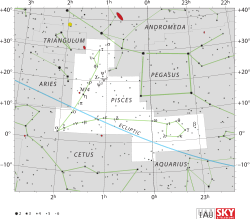Xi Piscium
Xi Piscium (ξ Piscium) is an orange-hued binary star[8] system in the zodiac constellation of Pisces. In 1690, the astronomer Johannes Hevelius in his Firmamentum Sobiescianum regarded the constellation Pisces as being composed of four subdivisions. Xi Piscium was considered to be part of the Linum Austrinum, the South Cord.[9] The star is visible to the naked eye, having an apparent visual magnitude of 4.60.[2] Based upon an annual parallax shift of 11.67 mas as seen from Earth,[1] it is located about 280 light years from the Sun. It is moving away from the Sun, having a radial velocity of +26 km/s.[3]
 | |
| Observation data Epoch J2000.0 Equinox J2000.0 (ICRS) | |
|---|---|
| Constellation | Pisces |
| Right ascension | 01h 45m 23.63185s[1] |
| Declination | +09° 09′ 27.8530″[1] |
| Apparent magnitude (V) | 4.60[2] |
| Characteristics | |
| Spectral type | K0 III[3] |
| U−B color index | +0.74[2] |
| B−V color index | +0.95[2] |
| Astrometry | |
| Radial velocity (Rv) | +26.13[3] km/s |
| Proper motion (μ) | RA: +72.98[1] mas/yr Dec.: +39.30[1] mas/yr |
| Parallax (π) | 11.67 ± 0.67[1] mas |
| Distance | 280 ± 20 ly (86 ± 5 pc) |
| Absolute magnitude (MV) | +0.78[4] |
| Orbit[5] | |
| Period (P) | 1672.4±1.4 d |
| Eccentricity (e) | 0.18±0.03 |
| Periastron epoch (T) | 2437651 ± 40 JD |
| Argument of periastron (ω) (secondary) | 71±9° |
| Semi-amplitude (K1) (primary) | 4.64±0.14 km/s |
| Details | |
| ξ Psc A | |
| Mass | 2.00[3] M☉ |
| Radius | 9[6] R☉ |
| Luminosity | 45.7[3] L☉ |
| Surface gravity (log g) | 2.8[6] cgs |
| Temperature | 4,947±25[3] K |
| Metallicity [Fe/H] | −0.11[6] dex |
| Rotational velocity (v sin i) | 0.0[6] km/s |
| Age | 1.22[3] Gyr |
| Other designations | |
| Database references | |
| SIMBAD | data |
This is a single-lined spectroscopic binary system with an orbital period of 4.6 years and an eccentricity of around 0.18.[5] The spectroscopic binary nature of this star was discovered in 1901 by William Wallace Campbell using the Mills spectrograph at the Lick Observatory.[10] The visible component is an evolved K-type giant star with a stellar classification of K0 III.[3] It is a red clump star, which indicates it is generating energy through helium fusion at its core.[11]
In non-Western astronomy
In Chinese astronomy, the "Outer Fence" (Chinese: 外屏; pinyin: Wài Píng) refers to an asterism consisting of ξ Piscium, δ Piscium, ε Piscium, ζ Piscium, μ Piscium, ν Piscium and α Piscium. Consequently, the Chinese name for ξ Piscium itself is "the Sixth Star of the Outer Fence" (Chinese: 外屏六; pinyin: Wài Píng liù)[12]
References
- van Leeuwen, F. (2007), "Validation of the new Hipparcos reduction", Astronomy and Astrophysics, 474 (2): 653–664, arXiv:0708.1752, Bibcode:2007A&A...474..653V, doi:10.1051/0004-6361:20078357.
- Argue, A. N. (1966), "UBV photometry of 550 F, G and K type stars", Monthly Notices of the Royal Astronomical Society, 133 (4): 475–493, Bibcode:1966MNRAS.133..475A, doi:10.1093/mnras/133.4.475.
- Luck, R. Earle (September 2015), "Abundances in the Local Region. I. G and K Giants", The Astronomical Journal, 150 (3): 23, arXiv:1507.01466, Bibcode:2015AJ....150...88L, doi:10.1088/0004-6256/150/3/88, 88.
- Anderson, E.; Francis, Ch. (2012), "XHIP: An extended hipparcos compilation", Astronomy Letters, 38 (5): 331, arXiv:1108.4971, Bibcode:2012AstL...38..331A, doi:10.1134/S1063773712050015.
- Pourbaix, D.; et al. (2004), "SB9: The Ninth Catalogue of Spectroscopic Binary Orbits", Astronomy & Astrophysics, 424: 727–732, arXiv:astro-ph/0406573, Bibcode:2004A&A...424..727P, doi:10.1051/0004-6361:20041213.
- Massarotti, Alessandro; et al. (January 2008), "Rotational and radial velocities for a sample of 761 HIPPARCOS giants and the role of binarity", The Astronomical Journal, 135 (1): 209–231, Bibcode:2008AJ....135..209M, doi:10.1088/0004-6256/135/1/209.
- "xi. Psc". SIMBAD. Centre de données astronomiques de Strasbourg. Retrieved 2017-07-25.
- Griffin, R. F.; Herbig, G. H. (1981), "Spectroscopic Orbits of Xi Piscium 60 Andromedae and ξ1 Ceti", Monthly Notices of the Royal Astronomical Society, 196: 33–43, Bibcode:1981MNRAS.196...33G, doi:10.1093/mnras/196.1.33.
- Hevelius, J. (1690), Firmamentum Sobiescianum, Leipzig. Fix.NN
- Campbell, William Wallace (1901), "Some recent results secured with the Mills spectrograph", Lick Observatory Bulletin, 1 (4): 22–25, Bibcode:1901LicOB...1...22C, doi:10.5479/ADS/bib/1901LicOB.1.22C.
- Tautvaišienė, G.; et al. (December 2010), "C, N and O abundances in red clump stars of the Milky Way", Monthly Notices of the Royal Astronomical Society, 409 (3): 1213–1219, arXiv:1007.4064, Bibcode:2010MNRAS.409.1213T, doi:10.1111/j.1365-2966.2010.17381.x.
- (in Chinese) AEEA (Activities of Exhibition and Education in Astronomy) 天文教育資訊網 2006 年 5 月 19 日